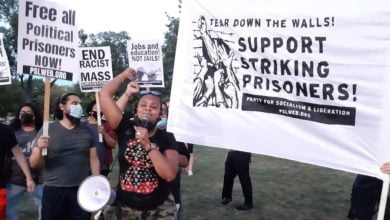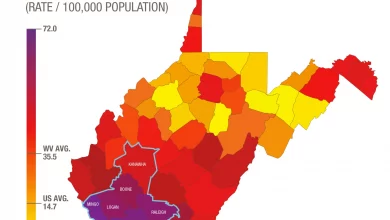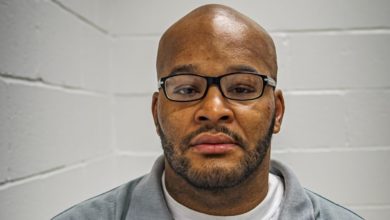NEW – Listen to this article
Across the country support for incarcerated people has become a rallying cry for all progressive people and organizations. Simultaneously, spontaneous prison actions of resistance have become increasingly regular in the face of the Coronavirus pandemic.
Inmates at the Lansing Correctional Facility in Kansas City started a tier wide uprising forcing guards to retreat from the section of the prison, cellhouse C, where incarcerated people set fires and stormed offices. A rallying call from the prisoner-made footage was “All Gas No Mask!” a play on the expression “All Gas No Brakes” to mean that there is no turning back now because of the lack of life saving personal protective equipment.
Other inmates in the video explained that they were being denied showers, being infected by guards, and even being denied food and dealing with water shutoffs in sinks and toilets—the impassioned explanation ended with a frustrated “We tired of talking!” A second prisoner testimonial in the facebook livestream repeated, “Y’all don’t wanna give us no healthcare?! This what we do,” and proceeded to smash prison offices.
The Lansing prison unit has already made the news prior to the riot for having confirmed COVID-19 cases in 16 staff and 12 inmates. Prison officials contained the rebellion after 10 hours, and have only committed so far to reducing movement and intermingling of the incarcerated population to the degree that it is possible. But on Friday, Kansas Corrections Secretary Jeff Zmuda answered questions during Governor Kelly’s news conference stating that there could be no social distancing because of the structure of the prison and that at best they could only hope to prevent intermingling of cohorts. Prisoners understood this to mean that they had no choice but to rise up.
A second viral video shot on a smuggled cell phone by Aaron DeShawn Campbell, an inmate at FCI Elkton, a federal prison in Ohio where three people have died from COVID-19 over the past week and at least 20 others are currently hospitalized, was a desperate plea for help. Campbell shows his cell mates laying still and explaining his previous cell mates have already been removed from general population because of the virus, “They got this motherf—er in my room. How the f— am I supposed to live? They talk to us about staying six feet away, they give us these little masks, but they literally like leaving us in here to die.” Campbell then shows from his window view a tent erected on the rec yard basket ball court “where they carrying the bodies to.” Campbell explains in the 20 minute Facebook live video that medical staff in the low security federal unit said, “Get ready because 80 percent of people in the unit are going to die.” “We’re stuck in here,” Campbell concludes.
Prison officials have responded to the video by claiming that it is one giant lie, even though former inmates have confirmed that the tent is indeed outside of the medical and special housing (solitary confinement) units.
In Chicago, a second prisoner at the Cook County Jail has died of COVID-19. Nearly 300 prisoners and more than 100 staff at the jail have tested positive. On Thursday, prisoners posted signs in the windows of their cells reading “Help, no supply” and “We’re dying.” Of course, the inmates are not lying as Chicago’s Cook County Jail has become the largest known single source of new COVID-19 infections—in a macabre race to be the worst of all worlds with New York City’s notorious Rikers Island Jail.
With multiple deaths already recorded, the Cook County Jail is under fire for allowing one person to die handcuffed to a hospital bed, ankles and wrists, guarded 24 hours by armed correctional officers. As of Thursday, 276 inmates and at least 115 staff members had tested positive for the coronavirus. And yet, as The New York Times notes, the authorities still haven’t tested all of the jail’s 4,500 inmates.
A lawsuit has helped move along the process of comprehensive and systematic testing in the jail, but all reports form a constellation of neglect and cruel mismanagement. Incarcerated people in the jail are furious with the glacial pace of relief efforts, and the doubling down of repression. As the situation has grown more dire, incarcerated people have taken bolder action, such as attacking guards in the middle of the night in order to take their keys to let people out. The situation was quickly controlled by authorities, but the action alone signals the level of struggle that incarcerated people are willing to take up in response to the pandemic.
In Oregon’s Columbia River Correctional Facility, tension erupted into physical conflict with correctional officers, forcing guards to retreat into their offices and hole up. One inmate reported, “People are tired of having inadequate cleaning supplies, of not being given masks, of being afraid to report feeling sick [sick people are reportedly being quarantined in solitary confinement cells], of not having enough soap.” A second incarcerated person reported, “Guards were telling us that we couldn’t wear masks,” said the inmate, who asked for anonymity out of fear of retaliation. “The [two units] stood up and said, ‘No, you don’t get to dictate our health. We outnumber you and we’re not going to take it anymore.’ Essentially, they forced the guards out of their units for about three hours.”
Inmates and criminal justice advocates have called on Gov. Kate Brown to release inmates who are nearing the end of their sentence to reduce the population size of Oregon’s prisons and prevent further spread of COVID-19. On Monday, seven Oregon prisoners filed a lawsuit against Brown and the Oregon Department of Corrections, accusing state officials of subjecting inmates to cruel and unusual punishment by not adequately protecting prisoners from COVID-19. Brown has since requested information from ODOC “related to the possible early release of inmates,”
In Seattle, Columbia Legal Services sued the state late last month on behalf of five inmates, asking the state Supreme Court to compel the release of everyone in Department of Corrections custody who is 50 or older; has serious health problems; or is scheduled for release in the next 18 months. Advocates have said few exceptions should be made to such categorical releases.
This lawsuit came as a response to a massive disturbance in the Monroe Correctional Complex after positive cases were reported. Correctional Officers offered Mcdonalds meals to younger inmates to convince them to move to the open air dormitories common to minimum security yards in which inmates are warehoused in 150 man cages with bunk beds so that older inmates could be relocated to the two-man cells. Inmates refused to move citing the lack of comprehensive cleaning in the infected tier citing that they will not allow “guards to play god with [their lives].” Inmated rebelled, destroying property and seizing fire extinguishers, threatening to take guards hostage.
Official efforts to decarcerate: too little, too slow
North Dakota and Utah were among a handful of states that moved to identify inmates who might be eligible for release in order to reduce prison populations. Utah began freeing the first of at least 80 inmates this month who both had a place to live that was approved by officials and had already been scheduled for release within the next three months. North Dakota planned to release more than 50 prisoners.
Efforts such as these, could be considered a step in the right direction, but relative to the risk they don’t even constitute a half step. Some 2.3 million incarcerated people are at risk of contracting this virus. So far, efforts to provide masks have been pitiful and stand in stark contrast to policies which dictate that prison labor will be used to make masks for the guards, or dig mass graves for their fellow incarcerated people.
Policies which have put a freeze on family visits have not prevented the spread of the virus. The allocation of one bottle of bleach for an entire prison unit, as was the case in an Alabama unit, are similar symptoms of the larger truth that the state is putting millions of people in position to die a premature and painful death.
Even the prison health boards are saying, despite their best efforts, that testing has been woefully insufficient and they can’t claim to know the full extent of the spread since limited testing kits have led to only testing those guards and inmates who show serious symptoms.
Federal prisons, state prisons, private prisons, local jails, juvenile facilities, and ICE detentions all need to move much faster and much more boldly towards decarceration on a mass scale. Almost all incarcerated people 50 or over, within the last few years of their outrageously long sentences, those with chronic illnesses, those with property crimes or victimless crimes, and so many more need to be released this very hour. We are at an impasse in which the state is going to decide if hundreds of thousands if not millions deserve a death sentence or not.
The capitalist ruling class has exponentially increased reliance on incarceration to resolve the deepening injustices of capitalism over the years: massive unemployment, de-industrialization, gentrification, homelessness, and debt. It has created a Frankenstein’s monster criminal justice system, which is getting more and more bold as their ranks swell and the neglect grows more and more nakedly hostile.
The rich and powerful show no inclination in stopping this rhythm. One Philadelphia judge denied every bid for early release, for a total of 380 denials in two days.
But that does not mean that authorities are immune from pressure by the people. New Jersey has released up to 20 percent of ICE detainees after imprisoned immigrants began a unit wide hunger strike that was sustained for weeks demanding the administration to act immediately.
The struggle will continue
What lessons can we draw from this moment in prison activism? So far, we are seeing a single pattern everywhere: prison uprisings, protest and lawsuits from supporters on the outside and some initial victories. The struggle inside the prisons gives concrete movement for activists to latch on to in order to win life-saving reforms. We can reasonably predict that the struggle will not slow down, but rather intensify.
The path forward is obviously difficult for those behind bars, but it is righteous. An incarcerated person fled a federal correctional facility in North Carolina only to give a TV interview the next day: “I take ownership of having to serve my time,” said Richard R. Cephas, 54, who had been at the Federal Correctional Complex serving time on a drug conviction. “I signed up for a jail sentence, not a death sentence.” This powerful testimonial of Cephas encapsulates perfectly the dichotomy born out here: the prisons must release the people, or the people will find a way to release themselves to escape death.
And it may take more than a few more Atticas to win necessary reforms and massive release of incarcerated people. But ultimately it will take a revolution to win justice for the working class, incarcerated or otherwise. The criminal capitalist government, the gangsterism of the courts, and the sadism of every prison warden have shown themselves to be the true monsters.
George Jackson, revolutionary socialist and hero to the prison struggle, often quoted Ho Chi Minh “When the Prison gates fly open the real dragon will fly out.” We say the sooner the better. Free the people! All gas no mask!






